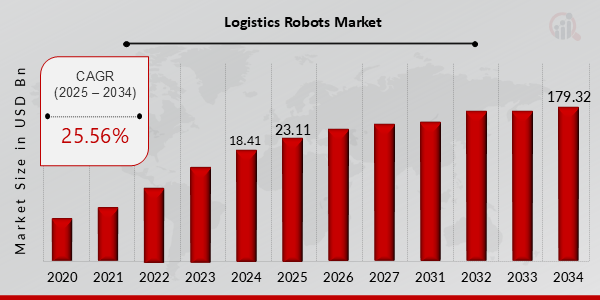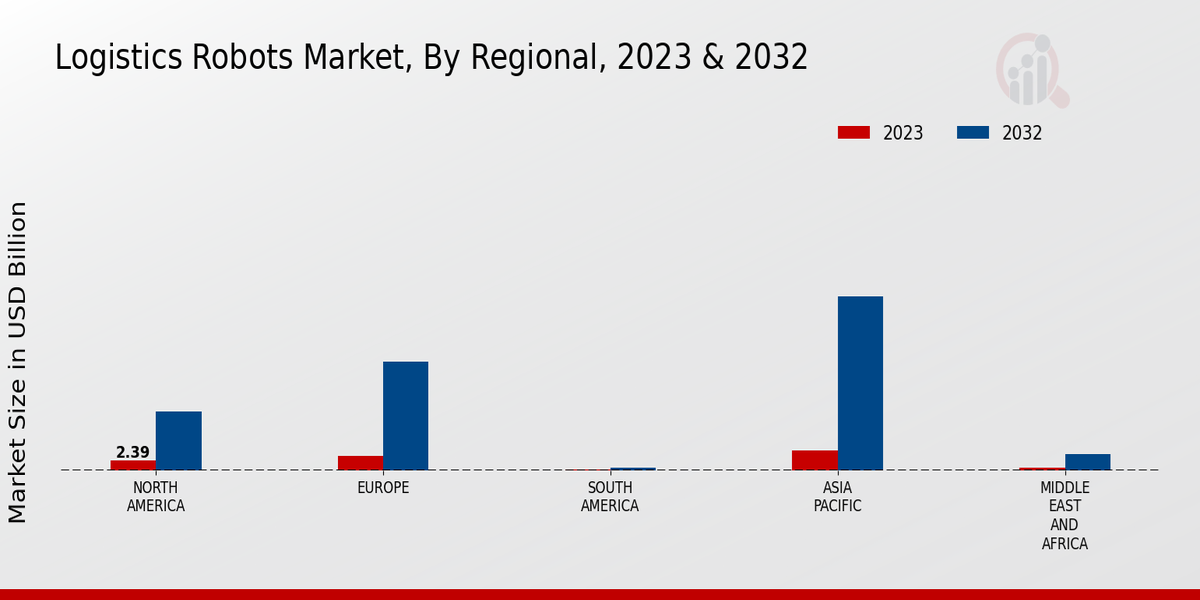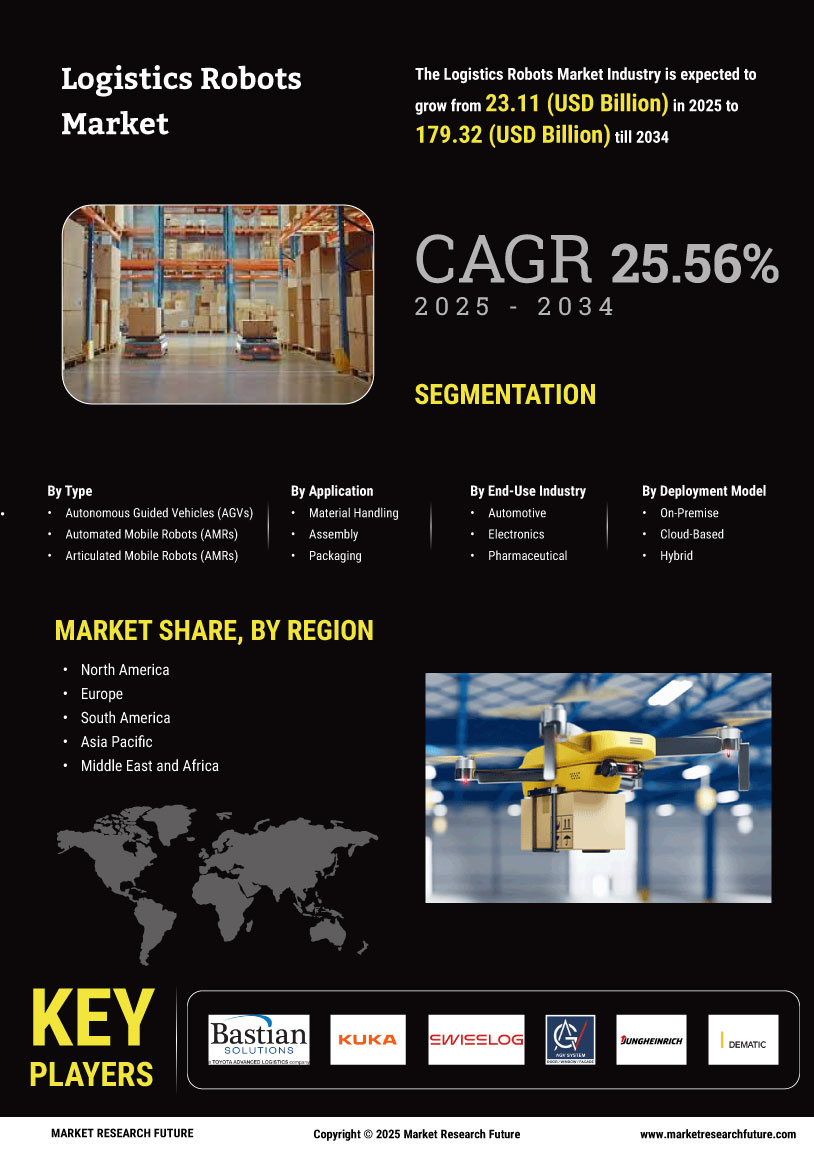Global Logistics Robots Market Overview:
Logistics Robots Market Size was estimated at 18.41 (USD Billion) in 2024. The Logistics Robots Market Industry is expected to grow from 23.11 (USD Billion) in 2025 to 179.32 (USD Billion) till 2034, exhibiting a compound annual growth rate (CAGR) of 25.56% during the forecast period (2025 - 2034).
Key Logistics Robots Market Trends Highlighted
The logistics robots’ market is rapidly growing due to an increasing number of users willing to save costs and enhance their efficiency. Due to the radical changes in the supply chain, businesses need to improve their efficiency and cut costs to implement such technologies. Some of the factors contributing to this trend include the rise of the e-commerce sector, labor shortages, and the need for timely delivery.1 There is still a lot of room for expansion within the logistics robot’s market. Order picking and stock management activities within warehouses and distribution centers are being carried out by autonomous mobile robots (AMRs). Also, last-mile delivery with drones is becoming unprecedented in cities. Particularly, the development of advanced artificial intelligence (AI) and machine learning (ML) also helps expand the capabilities of logistics robots in more complicated environments doing more advanced work. Overall, the analysis of trends in the robotics market indicates the usage of 5 retireaways with their outstanding features. Other trends include the rise of friendly robots which can operate collaboratively with other humans. The above trends are expected to improve the logistics market by embracing the use of robots in response to the changing demands and nature of the market.

Source: Primary Research, Secondary Research, MRFR Database and Analyst Review
Logistics Robots Market Drivers
Growing Demand for Efficiency and Productivity in Logistics Operations
One of the most important market drivers is the increasing pressure on the logistics industry. The market in question has been exposed to a huge range of changes because of the development and success of e-commerce and omnichannel retailing. These changes make it necessary to improve efficiency and productivity, which can be achieved by means of robotics. The implementation of such robots in the logistics industry can free human workers from time-consuming and monotonous tasks such as picking, packing, and sorting. In addition to that, the use of logistics robots also has the potential to improve the accuracy of each process and, therefore, reduce mistakes and errors, which can correspond to cost savings.
Advancements in Technology
The market for Global Logistics Robots is increasing with the expansion of this industry sector worldwide due to the advancement of technology. The development of new technologies, such as artificial intelligence, machine learning, and computer vision, is driving the growth of the logistics robots industry. These new technologies are making robots smarter and more autonomous, allowing them to do more complex tasks. The development of new materials and components is making robots more durable and reliable.
Government Regulations and Initiatives
Government regulations and initiatives influence the growth of the Logistics Robots Market Industry as well. In an overwhelming number of nations, governments are realizing the potential effects of logistics robots on improving the sustainability and efficiency of these industries. Furthermore, many initiatives and regulations have been instigated by relevant countries which support the use of such robots.
Logistics Robots Market Segment Insights:
Logistics Robots Market Type Insights
According to the type, the Logistics Robots Market is segmented into Autonomous Guided Vehicles, Automated Mobile Robots, Articulated Mobile Robots, and Unmanned Aerial Vehicles. AGVs are electrically powered vehicles that can transport materials to the destination along the predefined path. AGVs operate in warehouses or other facilities, undertaking the same functions as warehousers, for example. The market for Autonomous Guided Vehicles is projected to rise from $1.5 billion in 2023 to $4.3 billion by 2032, growing at a CAGR of 12.5%. AMRs are self-navigating robots equipped with sensors and cameras to operate in a given facility without a predefined path.AMRs avoid obstacles with the help of built-in sensors and navigate with the help of cameras. The Automated Mobile Robots market is projected to rise from $0.9 billion in 2023 to $3.1 billion by 2032, growing at a CAGR of 15.3%. AMRs can take different forms and are usually equipped with grabbing devices to lift and carry loads. The market of Articulated Mobile Robots, AGV’s subspecies, is projected to increase from $0.4 billion in 2023 to $1.3 billion by 2032, growing at a CAGR of 14.8%. UAVs are autonomous aircraft controlled remotely or programmed to operate without manual control.UAVs operate by the same mechanism as piloted aircraft but without a human pilot on board. Drones are becoming increasingly popular in logistics; for instance, they are used to deliver packages and check inventory in storage facilities. The UAV market is projected to rise from $0.2 billion in 2023 to $0.9 billion by 2032, growing at a CAGR of 18.5%. The logistics robots market is growing rapidly due to the increasing desire of companies to automate the entire process, the rising labor force cost, and a greater need for effectiveness. Robots allow companies to reduce costs and enhance productivity to meet their customers’ requirements.

Source: Primary Research, Secondary Research, MRFR Database and Analyst Review
Logistics Robots Market Application Insights
The application segment plays a pivotal role in shaping the Logistics Robots Market landscape. Material Handling, Assembly, Packaging, Warehouse Management, and Inventory Management are the key applications of logistics robots, each contributing significantly to the industry's growth. Material Handling dominates the market, accounting for over 40% of the Logistics Robots Market revenue in 2023. The surging demand for efficient and automated material handling solutions in industries such as manufacturing, warehousing, and retail drives this segment's growth. Assembly applications are also gaining traction, with an estimated market size of USD 12.54 billion in 2023. The increasing adoption of collaborative robots (cobots) in assembly lines enhances productivity, precision, and safety. Packaging and Warehouse Management are other prominent applications driven by the e-commerce boom and the need for efficient order fulfillment. This growth is attributed to the rising demand for automation, technological advancements, and the increasing adoption of Industry 4.0 solutions across various industries.
Logistics Robots Market End-Use Industry Insights
The end-use industry segment plays a crucial role in shaping the Logistics Robots Market. Among the key industries driving market growth are automotive, electronics, pharmaceuticals, retail, and e-commerce. Automotive: The automotive industry is a significant consumer of logistics robots, utilizing them for tasks such as material handling, assembly, and quality control. The rising demand for automation in automotive manufacturing is expected to drive segment growth. Electronics: The electronics industry heavily relies on logistics robots for efficient production and distribution. Robots are used for delicate component handling, circuit board assembly, and testing, enhancing productivity and accuracy. Pharmaceuticals: The pharmaceutical industry places a high value on precision and compliance, making logistics robots essential for maintaining strict quality standards. Robots assist in tasks such as drug storage, inventory management, and order fulfillment, ensuring the safe and timely delivery of pharmaceuticals. Retail: The retail industry is rapidly adopting logistics robots to streamline operations in warehouses and distribution centers. Robots automate tasks such as product picking, packing, and shipping, leading to increased efficiency and reduced labor costs. E-commerce: The e-commerce industry is a major growth driver for the logistics robots market. The surge in online shopping has created a need for efficient and cost-effective fulfillment solutions. Logistics robots play a vital role in order processing, packaging, and shipping, enabling faster and more accurate order deliveries.
Logistics Robots Market Deployment Model Insights
The Logistics Robots Market is segmented by Deployment Model into On-Premise, Cloud-Based, and Hybrid. Among these, the On-Premise segment held the largest market share in 2023, accounting for over 60% of the Logistics Robots Market revenue. This is due to the high upfront investment costs associated with On-Premise deployments, which can be a barrier to entry for smaller companies. However, the Cloud-Based segment is expected to witness the highest market growth over the forecast period, with a CAGR of over 28%. This growth is attributed to the increasing adoption of cloud-based solutions by businesses of all sizes, as they offer several advantages, such as scalability, flexibility, and cost-effectiveness. The Hybrid segment is also expected to witness significant growth, as it offers a combination of the benefits of both On-Premise and Cloud-Based deployments.
Logistics Robots Market Propulsion System Insights
The propulsion system segment plays a crucial role in determining the performance and efficiency of logistics robots. Among the various propulsion systems available, electric, pneumatic, and hydraulic systems are the most commonly used. Electric propulsion systems, powered by batteries or fuel cells, offer high efficiency and low operating costs. They are particularly suitable for applications requiring precise control and low noise levels. The Logistics Robots Market revenue generated from electric propulsion systems is expected to reach USD 35.6 billion by 2024, exhibiting a CAGR of 28.5%. Pneumatic propulsion systems utilize compressed air to power the robot's movement. These systems offer simplicity, low maintenance requirements, and the ability to operate in harsh environments. The Logistics Robots Market segmentation by pneumatic propulsion systems is projected to reach USD 18.9 billion by 2024, with a CAGR of 24.1%. Hydraulic propulsion systems, which rely on hydraulic fluid to transmit power, provide high force and torque capabilities. They are often used in applications requiring heavy lifting or precise positioning. The Logistics Robots Market data for hydraulic propulsion systems is forecasted to reach USD 16.3 billion by 2024, with a CAGR of 22.8%. The choice of propulsion system depends on factors such as the robot's payload capacity, operating environment, and desired performance characteristics. By understanding the specific requirements of each application, manufacturers can optimize the propulsion system to enhance the efficiency and productivity of logistics robots.
Logistics Robots Market Regional Insights
The Logistics Robots Market is segmented into North America, Europe, APAC, South America, and MEA. The APAC region is expected to dominate the market in 2023, accounting for over 40% of the global market share. The growth of the APAC region is attributed to the increasing adoption of automation in the logistics industry, particularly in countries such as China, India, and Japan. The European region is expected to follow APAC, with a market share of around 30% in 2023. The market growth in Europe is attributed to the presence of a large number of manufacturing and logistics companies in the region.North America is expected to hold a market share of approximately 20% in 2023, driven by the adoption of advanced technologies and the presence of major logistics hubs. South America and MEA are expected to account for a smaller share of the global market in 2023 but are expected to witness steady growth in the coming years due to the increasing investment in infrastructure and logistics operations.

Source: Primary Research, Secondary Research, MRFR Database and Analyst Review
Logistics Robots Market Key Players and Competitive Insights:
Major players in the Logistics Robots Market industry are continuously engaging in research and development activities to introduce technologically advanced products to stay ahead of the competition. Leading Logistics Robots Market players are focusing on developing robots that can operate autonomously and collaborate with other robots to improve efficiency and reduce operational costs. The Logistics Robots Market industry is characterized by the presence of well-established players as well as emerging startups. Strategic partnerships and collaborations between players are also prevalent in the Logistics Robots Market development as companies seek to expand their product offerings and geographical reach. The competitive landscape of the Logistics Robots Market is expected to remain dynamic in the coming years, with new entrants and innovative technologies shaping the market landscape.Out of many leading Logistics Robots Market players, Fetch Robotics is one of the dominant companies. The company offers a range of autonomous mobile robots (AMRs) designed for various material handling applications in warehouses and distribution centers. Fetch Robotics' AMRs navigate autonomously using advanced sensors and software, enabling them to collaborate with human workers and improve operational efficiency. The company has a strong customer base in North America and Europe, and it plans to expand its presence in other regions. On the other side, 6 River Systems is another leading competitor in the Logistics Robots Market. The company offers a comprehensive suite of AMRs and warehouse management software. 6 River Systems' robots are designed to work collaboratively with each other and with human workers, optimizing warehouse operations. The company has a significant market share in North America and is expanding its presence in Europe and Asia. 6 River Systems' focus on innovation and customer satisfaction has helped it gain a strong reputation in the Logistics Robots Market.
Key Companies in the Logistics Robots Market Include:
Logistics Robots Industry Developments
The Logistics Robots Market is anticipated to grow from USD 11.68 billion in 2023 to USD 90.6 billion by 2032, at a CAGR of 25.56% during the forecast period. The growth of the market is attributed to factors such as the increasing demand for automation in logistics operations, the rising adoption of e-commerce, and the growing need for efficient and cost-effective supply chain management. Recent news developments in the market include the launch of new products by major players such as Amazon and Fetch Robotics, as well as partnerships and collaborations between companies to develop and integrate logistics robots into their operations. The market is also witnessing the emergence of new technologies, such as AI and machine learning, which are being used to enhance the capabilities of logistics robots.
Logistics Robots Market Segmentation Insights
Logistics Robots Market Type Outlook
Logistics Robots Market Application Outlook
Logistics Robots Market End-Use Industry Outlook
Logistics Robots Market Deployment Model Outlook
Logistics Robots Market Propulsion System Outlook
Logistics Robots Market Regional Outlook
|
Report Attribute/Metric
|
Details
|
|
Market Size 2024
|
USD 18.41 Billion
|
|
Market Size 2025
|
USD 23.11 Billion
|
|
Market Size 2034
|
USD 179.32 Billion
|
|
Compound Annual Growth Rate (CAGR)
|
25.56% (2025-2034)
|
|
Base Year
|
2024
|
|
Market Forecast Period
|
2025-2034
|
|
Historical Data
|
2020-2023
|
| Market Forecast Units |
USD Billion |
| Key Companies Profiled |
Bastian Solutions, Kuka, MiR, Swisslog, AGV System, Jungheinrich, Dematic, YASKAWA, Geek+, Locus Robotics, Omron, Hikrobot, Knapp, FANUC |
| Segments Covered |
Type, Application, End-Use Industry, Deployment Model, Propulsion System, Regional |
| Key Market Opportunities |
Ecommerce growth. Labor shortages. Automation advancements. Customized solutions. Expanding applications |
| Key Market Dynamics |
Rising ecommerce penetration. Increasing automation in the supply chain. Growing demand for efficient logistics solutions. Advancements in robotics and AI. Government support for automation |
| Countries Covered |
North America, Europe, APAC, South America, MEA |
Frequently Asked Questions (FAQ) :
The Logistics Robots Market is expected to reach an overall valuation of 18.41 billion USD in 2024, with a projected growth to 179.32 billion USD by 2034, exhibiting a CAGR of 25.56%.
The Asia-Pacific region is projected to dominate the Logistics Robots Market, primarily driven by the increasing adoption of automation and e-commerce in countries like China, Japan, and South Korea.
Logistics Robots are utilized in various applications, including order fulfillment, inventory management, transportation, and warehousing. They enhance efficiency, accuracy, and productivity in logistics operations.
Prominent players in the Logistics Robots Market include names such as Amazon Robotics, Fetch Robotics, Locus Robotics, MiR, and Geek+. These companies offer a range of solutions to cater to the diverse needs of the logistics industry.
The Logistics Robots Market is driven by factors such as the increasing demand for efficient supply chain management, the rising adoption of e-commerce, and the need for labor optimization in logistics operations.
The Logistics Robots Market faces challenges such as high upfront investment costs, technological complexities, and the need for skilled personnel to operate and maintain these robots effectively.
The Logistics Robots Market is expected to witness continued growth, with advancements in technology, such as AI and IoT, leading to the development of more sophisticated and autonomous robots. Additionally, the increasing adoption of cloud-based platforms is expected to enhance the integration and collaboration of logistics robots within supply chains.
Key trends in the Logistics Robots Market include the adoption of collaborative robots, the integration of AI for autonomous navigation and decision-making, and the growing emphasis on data analytics to optimize logistics operations.
The growth of e-commerce has significantly impacted the Logistics Robots Market. The increasing demand for fast and efficient delivery services has driven the adoption of logistics robots to meet the requirements of online retailers and consumers.
Companies can leverage Logistics Robots to improve their operations by automating repetitive tasks, increasing efficiency, reducing labor costs, and enhancing overall supply chain visibility and control.

















